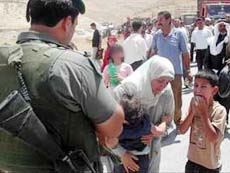There is a bottleneck of people at the small entrance to Endless Checkpoints, a recently opened photography exhibition in Tel Aviv.
To get into the main exhibition hall, where pictures of daily strife at a series of
And here is where they stop.
Hundreds of Palestinians are depicted waiting to reach the inspection point, squashed, flanked by wire fences. The camera pauses on a young mother on the edge of tears as she tries to comfort a screaming toddler.
Like the photographs on display inside, this is not an uncommon image. But it is one that it is rarely seen inside
One visitor from
"It's absurd that this has gone on for so long and impossible that it will stay this way."
Endless Checkpoints, at the
Since 2001, this organisation of about 400 women against the occupation has maintained a daily presence at checkpoints, to protest, to witness, to monitor and in some cases to exert a restraining effect on the Israeli soldiers on duty.
Documenting checkpoints
Esti Tsal, one of the exhibition curators, says: "We stand there every day, twice daily, to protest and also to document and to tell others what is not being told."
Inside the main hall, about 80 photographs, taken by the women of Machsom Watch, provide documentation of Palestinian encounters with Israeli soldiers at checkpoints.
There is a full wall display of pictures showing schoolchildren crossing barbed wire, cement blocks and piles of rubbish, or having schoolbags inspected by soldiers.
There is a series of shots of a soldier's pointed finger protruding from a concrete inspection kiosk, gesturing for Palestinians waiting to pass outside to open bags of clothing or plastic bags of pitta bread for inspection.
A male visitor from
"The Jew for 2000 years was at the checkpoint as a refugee, but now he has become the soldier at the checkpoint. So the question is, how do you retain your morality as a sovereign state, that you maintained as a minority?"
Introspection
Simon McDonald, the British ambassador to
"These pictures do not tell the whole story, and it is important to have that in mind when looking at the photos, but they do tell an important part of the story," he said.
"A sign of a healthy democracy is one that is not afraid to take a hard look at its problems and to deal with them. I think that the women of Machsom Watch help
Since these photographs span a period of four years, they also chart the progress of checkpoints, from barriers in the road to sophisticated terminals - known as "border crossings" - consisting of processing sheds flanked by access turnstyles.
Tsal says: "They are more modernized and more cruel, more inhumane, all pavements and walls and gates and Jeeps. You don't see people any more because they are inside the terminal buildings and we cannot go in and see them, speak with them."
The exhibition's location on the outskirts of Tel Aviv will necessarily limit its audience, but it seems Machsom Watch could not find another home for it.
"For more than a year, we were looking for a space in central Tel Aviv that everybody could reach," says Tsal. "We got a big 'No' from many galleries and commercial spaces we approached."
Media publicity
Endless Checkpoints has received a surprising amount of media publicity - appearing in Israeli newspapers and listings magazines such as Time Out and cropping up on TV news, on daytime programmes and evening culture show slots.
"I am very surprised, as I was sure nobody would care," says Tsal. "But it has been in the media almost every day."
Still, exhibitors worry that Endless Checkpoints may reach only an already sympathetic audience.
Giora Salmi, manager of the college, says: "It is really popular compared to other exhibitions here.
"But most people who come are already sympathetic to the work of Machsom Watch; they already agree. We want to reach other people, the ones who ordinarily visit galleries because they are fond of art."
Some visitors found the exhibition limited in its power to properly convey reality.
A visitor from Tel Aviv said: "It can't do the situation justice because these are just pictures. You can't smell a picture, have the feeling of fear, the feeling of oppression in a picture - it can't be the same as seeing it in real life."
Opinions
Another female visitor agreed: "I find the exhibition extraordinary, but the pictures are too beautiful and a bit glossed over, while the reality is very depressing and very bad."
A few visitors are angered by the "unbalanced" nature of the exhibition. "Some of my students were upset that the photographs do not explain what the soldier in the frame is feeling," says Salmi.
There are a few unfavourable comments in the exhibition visitor's guest book too, say the curators, describing Machsom Watch as "stupid women" who "don't understand".
But for those Israelis who are unable to visit these checkpoints, because they cannot or are too afraid, these photographs are the next best thing.
Tsal says: "We are trying to have Israeli society look in the mirror and say, 'We cannot go on like this, controlling two million people. Our face has become very ugly.'"


 Home
Home Discover Islam
Discover Islam Quran Recitations
Quran Recitations Lectures
Lectures
 Fatwa
Fatwa Articles
Articles Fiqh
Fiqh E-Books
E-Books Boys & Girls
Boys & Girls  Articles
Articles










